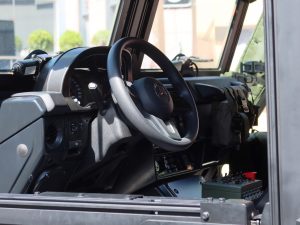
Rheinmetall unveils its Caracal light airborne vehicle at Eurosatory
Rheinmetall is leading a team of three companies in proposing its light airborne solution, the Caracal, to the German Army, which Rapid Deployment Division, the Division Schnelle Kräfte, is looking for a replacement for the legacy Luftlande-Wolf. The programme is fully funded, and is part of the 100 billion Euro for defence acquisitions announced by the German Government following the start of the war in Ukraine.
No official figures have yet been provided, but a realistic estimate puts the need at around 2,000 vehicles. On the other hand the Dutch Army also needs a similar vehicle, and it is well known that German and Dutch land forces have often selected the same platforms and weapon systems, the need being here considered about half of that of the Bundeswehr.
The Rheinmetall team is composed of Mercedes-Benz, which provides the vehicle chassis, and ACS (Armoured Car Systems), part of the Gruma Group, which since its formation in 2003 developed the Enok series of vehicles in different versions.
Some years ago Rheinmetall proposed a vehicle named Caracal to the Bundeswehr, but this one is completely new as it is based on a new chassis, a new superstructure, and integrates new subsystems.
The vehicle unveiled at Eurosatory is based on the new Mercedes-Benz G-Class 464 chassis that was unveiled in Graz in September last year, which production is being started in the capital of Styria, the Caracal prototype being built on one of the pre-production chassis. As the German requirement asks for two vehicles to be carried inside the CH-47F Chinook, the heavy-lift helicopter recently selected by Germany, the base version of the Caracal is based on the standard chassis that has a 2,850 mm wheelbase. Compared to the G-Wagen the Caracal is slightly more compact; it is 4,350 mm long, 1,810 mm wide and 1,850 mm high, the latter measures also imposed by Chinook air transportability. While the length of the vehicle would allow loading two Caracal inside the Chinook, weight might be an issue if maximum range is required. It is to see if the two-vehicle requirement will be confirmed in the RfQ, which has not yet been issued.
The superstructure, developed and produced by ACS, is bolted and can therefore be easily disassembled, a foldable ring mount being fitted on the top, and rotated inside the structure when the vehicle must be loaded on the helicopter. Standard armament is a 12.7 mm machine gun or a 40 mm automatic grenade launcher on the base transport vehicle. Other variants are required such as reconnaissance, ambulance, command post and combat engineer. The base vehicle is not protected, however ballistic and mine armour packages can be installed, providing a protection that will probably not exceed Level 1.
According to released information the Euro 3, 3-liter Mercedes-Benz OM656 6-cylinder in-line turbodiesel engine rated at 183 kW (249 hp), which provides a 600 Nm torque between 1,400 and 2,880 rpm, ensures a maximum on-road speed limited to 140 km/h for safety reasons, the engine being coupled to a Mercedes-Benz 9G-Tronic gearbox. The new Mercedes-Bens 464 is fitted with ABS and ESP, the electronic stability system being quite unique among this category of vehicles. The baseline Caracal has a 4.9 tonnes GVW with a minimum 1.5 tonnes payload, air transport weight being under 4.4 tonnes. The empty weight of the unarmoured vehicle is 2,900 kg to which we must add the mission kit, which however is not yet fully defined.
In the Caracal Rheinmetall is responsible for all sub-systems integration, of the electrical system, of mission kits design and integration, and of the vehicle assembly, testing and documentation. It is also in charge of sales and of the integrated logistic support.
Beside the standard Caracal, a longer version is planned, based on the G-Class 464 Chassis Cab 4×4 BA09 G 350 d chassis, with a 3,650 mm wheelbase. Of course only one of those vehicle will fit into the Chinook, and this should be the version used for infantry group transport as well as for materiel transport, the flatbed being able to load the typical 800×1,200 mm NATO pallet. Should Bundeswehr requirements need it, the ambulance version might migrate from the short to the long wheelbase chassis.
As its competitors, the Rheinmetall team is awaiting the Bundeswehr decision, which is expected soon.
Photos by P. Valpolini





